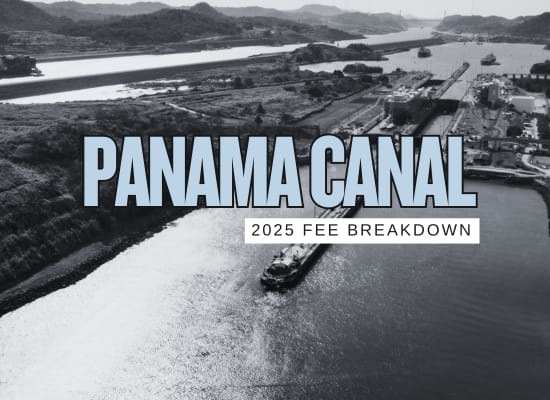Panama Canal Transit Fees Explained: 2025 Edition

The Panama Canal is one of the most critical—and costly—chokepoints in global trade. In 2025, fees have reached record highs, and shipowners are feeling the pinch. Whether you're running a container ship, LNG carrier, or bulk vessel, understanding how these tolls work is key to planning profitable voyages.
From base transit fees to last-minute reservation penalties that can top $350,000, we’re breaking it all down. Use our interactive calculator to estimate your own fees, then dive into the detailed tables below to see what’s driving the costs in 2025—and how to avoid overpaying.
⚠️ Disclaimer: This calculator is for informational purposes only and provides an estimated Panama Canal transit fee based on publicly available data as of 2025. Actual costs may vary depending on vessel specifics, cargo type, seasonal surcharges, and Panama Canal Authority (ACP) policies. For official pricing or slot reservations, please consult the ACP website or your shipping agent.
We welcome your feedback, suggestions, corrections, and ideas for enhancements. Please click here to get in touch.
ShipUniverse: Panama Canal Fee Estimator (2025 Beta)
| Vessel Size Category: | |
| Vessel Type: | |
| Capacity (TEUs / PC/UMS tons / barrels): | |
| Cargo Status: | |
| Reserve Transit Slot? | |
| Last-Minute Reservation? | |
| 🧮 Estimated Panama Canal Transit Fee: - | |
Vessel Size
Before you even get to toll calculations, the Panama Canal wants to know one thing: how big is your ship? That one detail — specifically your vessel’s beam (width) — determines which lock system you’ll use and sets the foundation for your entire transit fee. Whether you’re in a classic Panamax-sized vessel or pushing the limits with a Neopanamax build, this classification impacts everything from toll rates to reservation priority. The table below breaks it down in plain English so you know exactly where your vessel fits and what to expect.
| ShipUniverse: Vessel Size Categories | ||
| Category | Beam (Width) | Explanation |
| Regular | Less than 27.74 meters (91 feet) | These are typically older, smaller ships that fit the original Panama Canal locks (Panamax). Most general cargo and small bulk carriers fall here. They still pay serious tolls, but get through without using the newer Neopanamax locks. |
| Super | 27.74 to under 32.61 meters (91–107 feet) | These ships are bigger but still Panamax-eligible. Think Medium Range (MR) tankers, large bulkers, and some modern cargo vessels. If your beam is over 27.74m, you’re paying higher rates and may face more scheduling pressure. |
| Neopanamax | 32.61 meters or more (107+ feet) | These big boys use the newer, expanded locks. Most modern container ships, LNG carriers, and VLGCs fall into this group. If you’re Neopanamax, expect higher tolls, more demand for slots, and stricter draft limits during drought season. |
A Breakdown of Panama Canal Fees
The Panama Canal doesn’t just charge a flat toll — it builds your fee from multiple layers that depend on your ship’s type, cargo, and reservation needs. From base tolls based on your vessel’s size to capacity charges, deck cargo surcharges, and even penalties for canceling late — the total bill can spike fast. This table breaks down the core fee components used in 2025 so you can understand exactly what you’re paying for and why. Knowing where the big-ticket charges come from helps you plan ahead and avoid surprises.
| ShipUniverse: Core Transit Fee Components – 2025 Breakdown | ||
| Fee Component | How It’s Calculated | Explanation |
| Base Transit Fee | Set by the vessel’s size category (Regular, Super, Neopanamax) and lock system used. Larger ships and those using Neopanamax locks pay significantly more. | This is your starting toll — it reflects the infrastructure you're using. Bigger ships cost more to move through the canal. |
| Capacity Charge | Charged per cargo unit: TEU for containers, barrels for tankers, PC/UMS tons for bulkers. Rates vary by vessel type. Example: ~$90/TEU (containers), ~$0.40/PC/UMS ton (bulk), ~$0.50/barrel (tanker). | This reflects how much cargo you’re actually transporting — the bigger your payload, the more you pay. It’s the variable part of your toll. |
| Ballast Discount | If you’re sailing empty (no cargo), you typically pay only 85% of the full transit fee. Not available for full-container ships. | Helpful for repositioning voyages — but doesn’t apply to container vessels, who pay full price even when empty. |
| Deck Cargo Charge | For vessels carrying containers or cargo on deck without being full container ships. Charged per TEU. | If you're a general cargo ship hauling containers on deck, this fee applies in addition to other capacity charges. |
| Reservation Fee | Optional but often necessary. Super vessels: ~$50,000. Neopanamax: ~$100,000. Regular vessels: none or minimal. | Reserving a slot guarantees your place in line — and saves you from potentially costly delays during peak season or drought restrictions. |
| Last-Minute Reservation Fee (LMTR) | If you missed regular reservation or auction, you can pay to jump the line. Super vessels: ~$100,000. Neopanamax: ~$200,000. | Painfully expensive, but better than missing your delivery window. This is for ships that need to move now, no matter the cost. |
| Late Cancellation Penalty | Cancel within 48 hours of your reserved slot? You’ll be charged up to 2.5x your reservation fee. | Brutal if plans change. A Neopanamax canceling late could eat a $350,000 fee. Make sure you’re committed before reserving. |
Reservation & Cancellation Fees
If you want to move through the Panama Canal on time, reserving a slot is a smart move — especially during peak season or when water restrictions cut daily capacity. But convenience comes at a price. The bigger your ship, the more you’ll pay to lock in a transit window. And if you cancel late or try to jump the line last minute, the fees stack up fast. This table breaks down the 2025 reservation system, including standard reservation fees, last-minute options (LMTR), and late cancellation penalties, so you can plan ahead and avoid six-figure surprises.
| ShipUniverse: Reservation and Cancellation Fees | |||
| Vessel Size Category | Standard Reservation Fee | Last-Minute Transit Fee (LMTR) | Late Cancellation Penalty |
| Regular | Typically not required | Not available | Minimal or none (if no slot reserved) |
| Super | $50,000 | $100,000 | Up to $175,000 (2.5x reservation fee) |
| Neopanamax | $100,000 | $200,000 | Up to $350,000 (2.5x reservation fee) |
Transiting the Panama Canal in 2025 isn’t just about getting from Point A to Point B — it’s about understanding the game so you don’t get blindsided by the bill. Between base tolls, cargo capacity charges, reservation fees, and costly last-minute changes, the numbers can climb fast. But if you know your vessel’s category, plan your reservations carefully, and use tools like the calculator above, you can avoid overpaying and make smarter routing decisions. As the canal continues to face water challenges and rising demand, being informed isn’t just helpful — it’s essential. Safe sailing.

Do you have a Maritime Product or Service that may be of interest to Shipowners? Tell us about it here!
Do you have feedback or insights? Please reach out to editor @ shipuniverse.com
